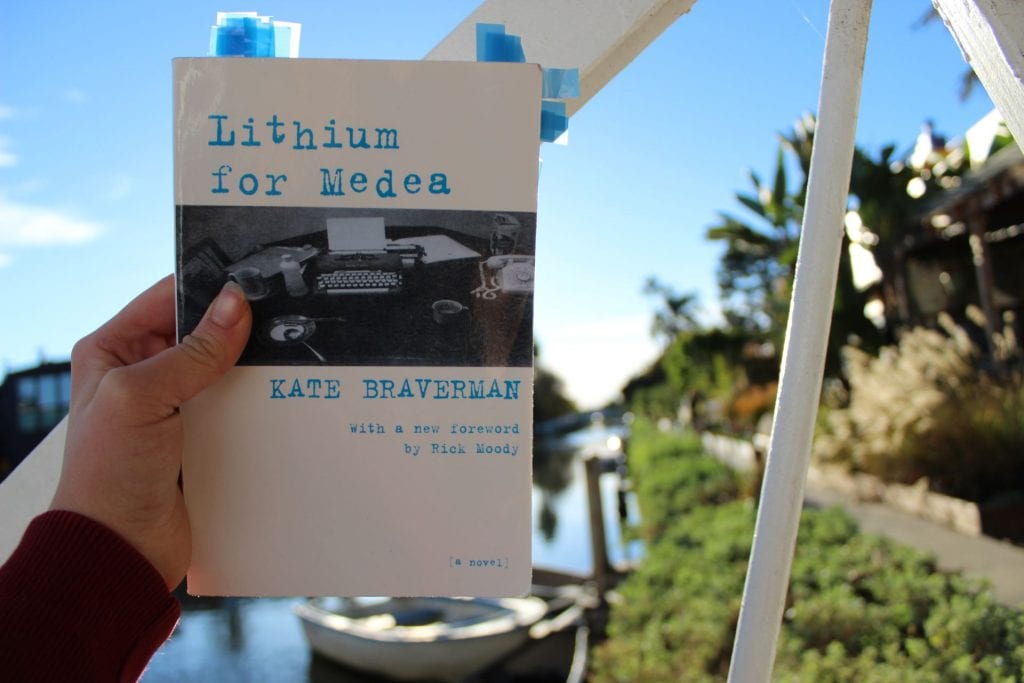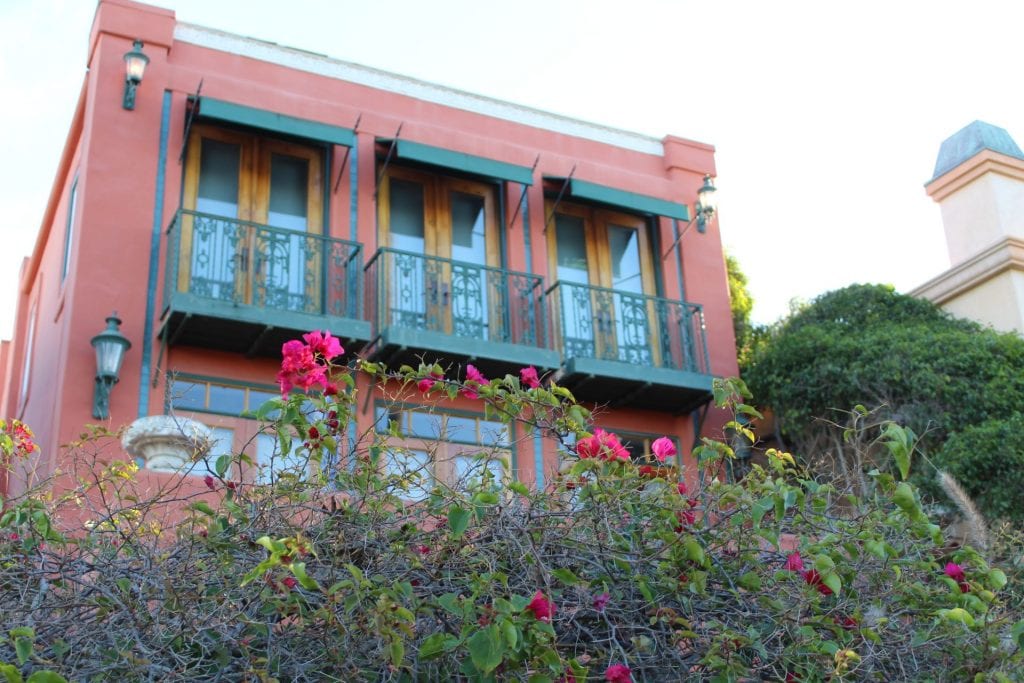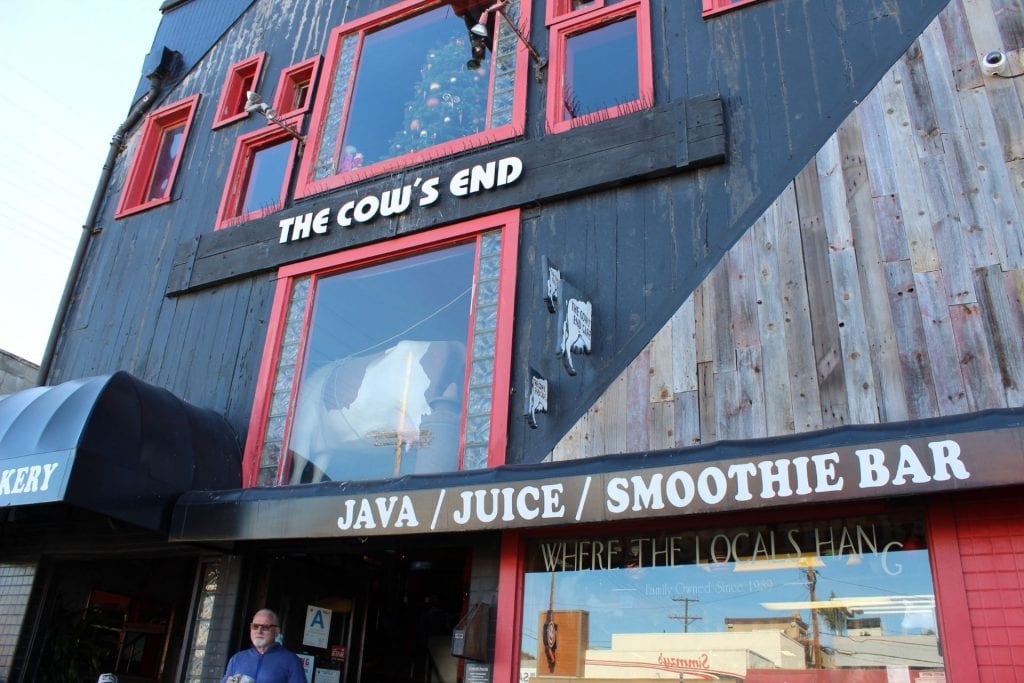“I realized that if these blocks and cement gouges were the alphabet of the future, then we lived at the edge of history. Los Angeles sits white and half dead already after the fact, already somehow gasping for breath, slowly strangling.”
Attempting to step into the shoes of an amphetamine addict, I walk down the white, paved walkway that lines the Eastern canal. Sitting on the edge, I imagine myself as Rose staring at the mirrored reflection of the sun rising against the water; the bright facades of varied homes left streaks of red, green, yellow and orange across the surface. I partially fail: my desires to understand her character will not suffice to also convince me to take drugs and fully re-enact Kate Braverman’s disturbed protagonist. However, I hold the novel and re-read the lines that convinced me to drive to the Venice canals at this ungodly hour: “in the early mornings when the sun is still pale and tentative, still wrapped in night haze, the canals are the color of a mirror, delicate silver.” In Lithium for Medea, Kate Braverman couples her poetic genius with a narrative that invites readers to explore her protagonist, who embodies the lost soul archetype of Los Angeles—a city full of the damned and fallen.
Although her novel also explores the broader Los Angeles, Braverman hones in on Venice. An area where wealth now coexists with poverty, Venice has served as a home of lost souls since its founding through to its present day. I walk along the Venice canals for a couple hours with my camera strap wrapped around my neck and find comfort in the quiet of the morning and stillness of the canals cutting through the roads of the residential neighborhood. Rose describes the different times of the day here as different seasons of each canal; they change from sunrise to sunset. Sherman, Howland, Linnie, and Carroll, each holds its own intricacies, designs, homes, families, and stories; the names help me separate them each as their own. I go from Eastern Canal, where Rose’s house resides, over to Grand Canal, where the home of her “lover” (Jason) sits. The two-story, red house boasts a Spanish villa architectural design—unsurprisingly, given Los Angeles’s ubiquitous habit of adapting other countries’ architectures in a sort of whimsical fashion. This design tendency speaks to Los Angeles’s history of whitewashing beginning by displacing Mexican American households while also adopting elements of their art and architecture as their own. This practice screams falsehood— a prevalent characteristic among Angelenos. From the chateau-style mansions to stuccos to Mediterranean villas, I stare at the homes in this Venice neighborhood attempting to estimate their age and to identify if Rose would have seen them during her time here.
As I walk away from the canals, I recall the elements from Braverman’s piece I actively seek to find. Lithium for Medea is an ode to the Beat Generation and the bohemian movement that filled Venice from the 50s to 70s. Rose spends her days with a syringe in her arm shooting up cocaine, walking down to the boardwalk and ocean, writing lyrical letters to a cousin she never met, sitting along the canals, visiting her cancer-stricken father in the hospital, and spending time with “lover” Jason—a manipulative, artistic cocaine junkie.
Braverman cautiously embraces this bohemian culture. Her depictions of a grungy Venice contrast Beverly Hills and other affluent Los Angeles neighborhoods. Nevertheless, Braverman fails to fully depict the beauty in Venice’s 60s and 70s grunge. During this time period, Venice served as a hub for this literary, artistic, revolutionary counter-cultural movement that Rose lives through in the piece. Venice was the remnants of an idealized, over-fantasized, utopian experiment from the early part of the century that failed and left behind ruins. Like Los Angeles as a whole, Venice was founded over a dream that never quite became reality. Abbot Kinney built this oasis in 1905 only for it to tumble after his death, become an oil drilling hub in the 30s and 40s, and make way for the “Slum by the Ocean” by the 50s and 60s. This rubbish attracts those post-war, pseudo-intellectuals seeking cheap rent and finding meaning in rubble and the denial of material possessions. The area’s decay holds some promise of reality and authenticity in a city full of false idealism. Perhaps, in the time period of its most decay, Venice came closest to reaching Abbot Kinney’s lofty aspirations for a community of forward-thinking intellectuals. The time period brought a proliferation of art, music, and cultural revolution.
“... Venice, where I live. Here the city stops its white cement sprawl, its hunger to engulf the whole earth’s under tons of trucked-in concrete. Here in the lap of the blue-eyed Pacific, Los Angeles is stopped dead by the sheer liquid cliffs of the sea.”
I seek to find what remains of this restless, nomadic nature along the streets Kate Braverman describes. From the canals, I walk over to Washington Blvd. and enter a local cafe, the Cow’s End. Bohemian Venice thrived in the bars and cafes of Rose’s time. However, I do not desire to drink alcohol, even the greatest of Moscow Mules, at 9:00AM so I set out for the latter. Venice West Cafe, the most famous of her time, made way for the Piccolo Restaurant (7 Dudley Avenue), an upscale and arguably overpriced spot where you could order ravioli for $30 until the joint also closed in 2013. However, the Cow’s End, founded in 1989, perfectly holds what I look for: a locals spot with a vibe from the past and a quality coffee. I walk in, order a latte, and make my way upstairs to a hang out spot with couches and tables perfect for conversing, writing, or lounging. I start overhearing the conversation of three elderly men. They are discussing politics (especially Trump), fake news, and social media (Twitter) as a form of news medium. As one gentleman gets up and goes downstairs, a chair opens up so I walk over to join them.
Robert, age 83, lived through the 60s and 70s of Los Angeles . His family came from Mexico in 1914; a reminder that we live in a city founded by migrants. He explains that his family amended his original last name to an Anglicized one. He also shows me pictures that date back to the time of his family coming to the United States. I introduce myself as a fellow Mexican, and he lists me movie recommendations including Under Any Moon and How to be a Latin Lover. After some background, he tells me that one simply did not go through Venice in the times of Rose. He commuted from Marina del Rey to Beverly Hills in those days and took the long route to avoid the area. He recalls a famous murder that happened on the street of the Cow’s End near that time. I later find countless articles on the death of Sara Ribicoff, a famous senator’s niece who was murdered sitting at a restaurant on Washington Blvd. Mel, Robert, and I chat of the gentrification of the area: they mention its most evident in the Abbot Kinney area, which I later traverse to.
I say goodbye to Mel and Robert and go downstairs to chat with Clay (pictured above), their third friend that happens to own the Cow’s End. At 76, Clay stands at the entrance of Cow’s End with a proud smile. Tatted, tall and strong, Clay—a biker in his free time—gives off a hospitable yet protective vibe over his joint. Well, he did build it himself 40 years ago and has lived on the upper floors ever since. At sunset, he sometimes sits down with a small glass of bourbon and a cigar to watch the sunset over the ocean and the Los Angeles skyline. Ironically, I recall that Rose’s father does the same in Lithium for Medea.
Clay tells me where he bought the wood and bricks and begins to recount the violence that taints Venice. Clay knows almost every local that walks into his cafe and has seen the progression of the storefront. He says the violence and drug use remain prevalent but perhaps less noticeable and more isolated: he himself was attacked outside his place just 3 years ago. Nevertheless, locals know to respect the Cow’s End. Clay enjoys the authenticity of those who come in; each one brings his or her own stories. Together, Clay and I bash together on the elitist, consumerism across town in Beverly Hills—the location of Rose’s mother’s house and home to many "boujee" cafes. I observe how he greets everyone who comes in. Many of the locals he knows by name and even remembers the names of their pets; he carries treats in his pockets for their dogs.
Contently walking away knowing I will come back some time, I decide to walk over to the ocean for a moment of reflection: all manifest destiny ends here. The ocean contains many paradoxes: endless hope or despair, unity or desolation, vastness or complete emptiness. I feel comfort staring out from the pier. However, here on the Venice Beach, Rose kills Jason’s cat Picasso in a trance of absolute despair over her father’s cancer and her own vices of drug abuse. She recounts the strength of the waves that border Los Angeles’s shores:
“I turned my back to the sea. I felt the power of the waves at my back hurtling and gnawing the shoreline, crashing and withdrawing, a kind of humming. I felt the rhythm, the wind, salt spray the land groaning while cold black water lapped around my ankles.”
On the boardwalk, I find countless elements of both the counter-cultural movement and lost-soul subculture that combine for a diverse, eclectic scene. Murals attempt to replicate the art scene of Rose’s day, and elements of the musical movement of the 60s stand out. I see a Jim Morrison mural placed over the sidewall of the Muscle Beach Venice gym building. Bodybuilders lay out on outside facilities; a reminder of the old tradition which started as a healthy outlet for anger and suppression to combat violence. This gym sits only two blocks from the historical beachside skate park: a monument to the Zephyr boys (Z-boys) and the skaters who approached the 60s renaissance using skateboarding as their platform for expression. I turn on my headphones and listen to The Doors, who founded their band in this 60s Venice artistic boom before reaching their international stardom. I imagine Rose and Jason singing along: “We chased our pleasures here. Dug our treasures there... Everybody loves my baby, She gets high.”
Jason, a complete vagabond, once stood on these streets. He lived on the streets, wandered the beach with his sketchbook, and subsisted on a diet of amphetamines, psychedelics, and the occasional peach taken from a tree. Venice also attracted great artists in its time: these streets saw Jean Michel Basquiat and Ed Ruscha, whose first solo exhibition ever opened in this part of town. As a reminder of this past, Venice still attracts the artists that sell their works along the boardwalk and preserves many of the murals. However, ironically, the original muralist art movement of Venice also alludes to the ubiquitous white-washing of Los Angeles. Original muralists arose from the Mexican movement using concrete as their canvas to speak of the suppression of minorities and underrepresentation of non-white males. In the 50s and 60s, beats and bohemians adopt this practice from those Mexican American artistic pioneers for their own counter-cultural messages. Present-day murals in Venice reflect parts of those two same sentiments but further adapt and alter them. Politically charged messages and counter-cultural images are placed next to commissioned pieces. To preserve its past, the Social Public Art Resource Center (SPARC), founded in 1976, attempts to memorialize the area’s art by collaborating with arts, the community, and local administration.
In order to observe the impact of gentrification on the neighborhood, I head to Abbot Kinney, named after the tobacco magnate who founded Venice. On Abbot Kinney, I observe the transient, counter-cultural elements from Lithium for Medea disappearing and making way for the falsehood Rose so often rejected of Los Angeles. The revolutionaries of the 60s and 70s now make way for internationalized muralists whose pieces are commissioned by businesses in the area to make their location “trendy.” I enter an art gallery that holds no local art: the prints (going for $400) exhibit white, male surfers in Bali. Tech enthusiasts enter the Tees and Jeans store to spend $200 on a “hipster” jean jacket. Pro tip: walk into Goodwill, buy a jean jacket, cut some holes in it for the “distressed” look, and add paint on the back if you desire so. Get the same look for $5. After Tees and Jeans, I walk into a flagship store of Toms and purchase a $4 tea—a cup with ONLY a bag and water—in order to have a place to sit and write before I forget some of my thoughts. I overhear people at the table next to me. A woman counsels them on their meditation: she is their paid mediation therapist. Meanwhile, everyone around her are dressed in their expensive “hipster” apparel: $90 Freebirds peep from under the table and a man with $150 Toms shades looks over. At least we are in the Toms store.
I start to think of Rose’s mother, Francine—a Beverly Hills social climber who desperately desires to ascend. "Los Angeles is a city dedicated to the telephone... They're constantly on the phone because here, in the City of Angels, where the elect have ascended, they often find themselves perched on cliff tops, on canyon tops, and hilltops, absolutely alone." Are the women of her era making way for the new social climber: a trendy woman of Abbot Kinney who spends way too much on yoga classes, a meditation therapist, a plethora of organic pricey moisturizers, her quality vegan diet, and a luxurious yet minimalist closet full of “hipster” clothes?
Post-tea, I end my day the way Rose ends hers by sitting watching the sunset over the canals. I recognize that I see a very different depiction of the scene from the one Braverman describes. New patio sets replace the rotted, oxidized chairs and cute, little canoes stand in place of dilapidated ones. I take out my camera a snap shots of the red and orange veins of reflection cutting through the dark waters. The area is vibrant and alive. In the same manner that I started my day, I flip back to page 59 and read Braverman's depiction of this season of the canals. She writes:
“At sunset the canals are streaked as the sky fierce reds and oranges, thick, the color of lava. I know this sun. It sits above me, a monk in red robes, a suicide at the immolation.”


















